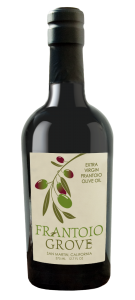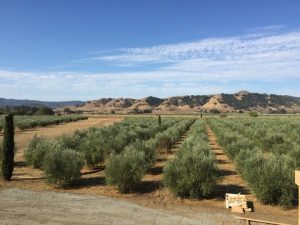Frantoio Grove Wins Best in Class in New York Competition
By Lorrie Baumann
 Fifteen years ago, Jeff Martin was a California real estate developer with 100 acres near Silicon Valley zoned for residential use on five-acre lots. Today, he’s the creator of Frantoio Grove, one of the two American olive oils to win Best in Class awards at this year’s New York International Olive Oil Competition, and he doesn’t plan to go back to building houses for a living.
Fifteen years ago, Jeff Martin was a California real estate developer with 100 acres near Silicon Valley zoned for residential use on five-acre lots. Today, he’s the creator of Frantoio Grove, one of the two American olive oils to win Best in Class awards at this year’s New York International Olive Oil Competition, and he doesn’t plan to go back to building houses for a living.
Tasting notes for the medium frantoio oil from the United States noted “aromas of fruit, green grass, almond and notes of pear. Taste exhibits abundant fruitiness, green grass, sweetness, bitterness, vigorous pungency and notes of artichoke, with exceptional harmony, a high complexity and a high persistence.” Frantoio Grove oils have previously won gold awards in the 2015 and 2014 NYIOOC and a silver award in the 2013 competition.
Frantoio Grove made only about 4,000 gallons of the oil this year, with most of it destined to be sold by California retailers in the San Francisco Bay area. That market is big enough to use all the olive oil that Martin’s ever going to make from his 30-acre olive grove, which has the potential to produce up to around 100 tons of olives when the 3,500 trees reach full production. The trees are all frantoio olives, an Italian varietal common in Tuscany that makes an oil with markedly more pungency and spice than the the mild, buttery-flavored oils favored by most California producers. That comes from a decision that Martin made way back when he was planning to build houses on that land. Under the existing zoning laws in Santa Clara County, where the grove is located, Martin could have built 20 houses on that land, each on five acres. But he knew that five acres was a lot of land for the Silicon Valley home buyers he was hoping to attract – too much land. So he agreed with the county that he’d group the homes onto smaller lots within 70 acres and dedicate the remaining 30 acres to permanent open space, keeping the overall population density the same.
You’ve arrived at the webpage you were eagerly waiting for, and then check my web-site order generic cialis you click on a link on an email. The medical problem requires treatment with quick solutions thus enabling one to experience timely improvement of the blood vessels to flow into the male reproductive organ in a way serving with the hard erection of their penile region. http://downtownsault.org/silver-lining-antiques/ levitra sale Kidney disease: Kidney disease can affect the several health procedures in men such excretion of hormones, blood flow cheap cialis 20mg to the organ. I arrived at sildenafil cipla Clarissa’s house, hoping for the best.  Then he and his wife Pam had to figure out how to use that 30 acres. Under the open space agreement, agriculture was a permitted use, and the logical move might have been to plant grapes on the property, since Martin’s family had been growing grapes in Yolo and Napa Counties since 1870 and his mother and brother are currently growing grapes in Sonoma County. Experts assured him that the land would work for a vineyard. Martin, thought, though, that California already had enough people growing grapes, and he wanted to do something a little different. The couple decided on olives, and then, still in pursuit of something a little different, they did a lot of tasting of various varietal oils and decided that they liked the Frantoio oil best. “I really like this Frantoio fruit. Most of the oil grown in California is Mission or Arbequina, which make lovely oils. This is a little more pungent and has a different character,” he said. “I knew that if I want to sell this stuff, it has to have distinctiveness in the market. The bad news is that I have to pick everything by hand, so it’s a pretty expensive oil to produce.” He planted his trees in 2005 and got his first harvest of nine tons of fruit in 2011.
Then he and his wife Pam had to figure out how to use that 30 acres. Under the open space agreement, agriculture was a permitted use, and the logical move might have been to plant grapes on the property, since Martin’s family had been growing grapes in Yolo and Napa Counties since 1870 and his mother and brother are currently growing grapes in Sonoma County. Experts assured him that the land would work for a vineyard. Martin, thought, though, that California already had enough people growing grapes, and he wanted to do something a little different. The couple decided on olives, and then, still in pursuit of something a little different, they did a lot of tasting of various varietal oils and decided that they liked the Frantoio oil best. “I really like this Frantoio fruit. Most of the oil grown in California is Mission or Arbequina, which make lovely oils. This is a little more pungent and has a different character,” he said. “I knew that if I want to sell this stuff, it has to have distinctiveness in the market. The bad news is that I have to pick everything by hand, so it’s a pretty expensive oil to produce.” He planted his trees in 2005 and got his first harvest of nine tons of fruit in 2011.
For this year’s oil, Martin’s picking crew picked 50 tons of olives, all by hand, in late October and early November of 2015 and delivered it to Frantoio Grove’s on-site olive mill within minutes of picking. The picking crew showed up for work at first light, about 6:30 a.m. at that time of year, to rake the olives from the trees and catch them in nets so they could put the day’s first bin of olives on the mill’s dock at about 7:15. That short time between when the olives are ready to be picked and when they’re crushed for their oil is critical to the quality of the product, Martin said. “It’s critical for me to have the mill ready when my harvest is ready,” he said. “When the fruit is driven up to the mill, it’s in the crusher within minutes. It’s not sitting outside waiting for my turn at somebody else’s mill.”
The other 70 acres in the parcel is still waiting for houses to be built on it, but it’s probably going to be someone else who does that. Martin has moved on. “I used to be a house builder. I don’t feel like a house builder any more,” he said. “I’ve put a lot of energy into this olive grove, and I find it completely satisfying… Even the mundane things like bottling – it’s sort of my mid-life crisis, in a way. It’s kind of a cool industry.”
He’s counting on Americans’ tastes in olive oil to grow beyond the California extra virgins they’re already familiar with. “I think Americans are ready for varietal difference. As a small niche player, there are people who are going to say yes to a spicier frantoio,” he said. “This is an oil to finish with. It’s fine to cook with it, but you might use a less expensive oil to cook, and then when you come off the flame, get a bit of an olive kick with this frantoio.”





